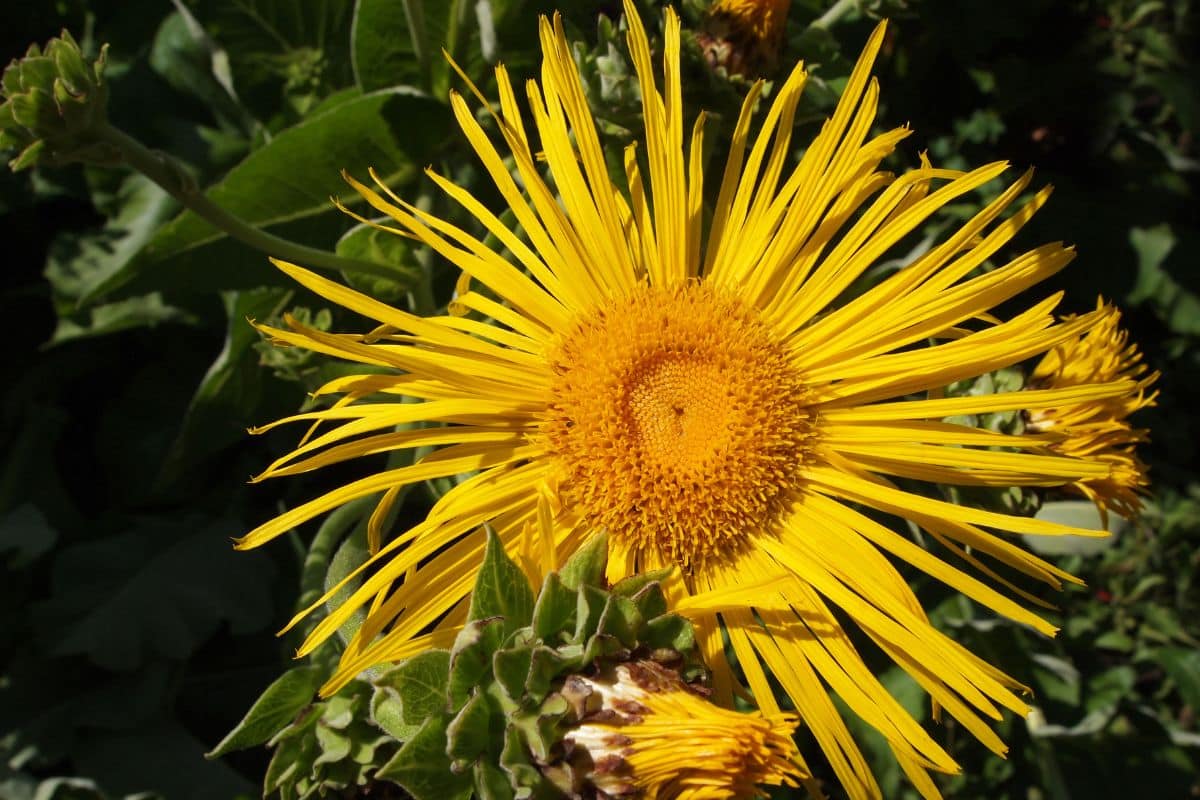Elecampane (Inula helenium) stands as a magnificent perennial herb that deserves thoughtful consideration when selecting neighboring plants. This towering medicinal plant, reaching heights of six feet, creates unique growing conditions that influence which companions thrive alongside it. Understanding the best companion plants for elecampane ensures optimal garden harmony and maximizes the benefits of this ancient healing herb.
The selection of appropriate companion plants depends on elecampane’s specific growing requirements and its impact on surrounding vegetation. This robust herb prefers moist, well-draining soil and partial to full sun exposure. Its deep taproot system and substantial foliage create both opportunities and challenges for neighboring plants. Successful companion planting with elecampane requires understanding these dynamics to create a thriving garden ecosystem.
Beneficial herb companions that enhance elecampane growth
Mediterranean herbs form excellent partnerships with elecampane, creating complementary growing conditions. Rosemary, thyme, and oregano establish natural pest deterrent systems while tolerating the partial shade cast by elecampane’s broad leaves. These aromatic herbs benefit from the wind protection that elecampane provides, particularly during harsh weather conditions.
Sage represents another outstanding companion choice, as its silver-gray foliage creates striking visual contrast against elecampane’s deep green leaves. Both plants share similar soil preferences and drought tolerance once established. The antimicrobial properties of sage complement elecampane’s medicinal qualities, creating a powerful healing garden zone.
Basil varieties demonstrate remarkable compatibility with elecampane, though proper care techniques remain essential. Learning how to keep your basil plant alive becomes crucial when positioning these tender annuals near the towering perennial. The protection elecampane offers helps basil survive temperature fluctuations while both plants benefit from similar watering schedules.
Mint family members, including spearmint and peppermint, establish successful partnerships with elecampane. These vigorous spreaders require containment, but their aggressive nature doesn’t intimidate the robust elecampane. The combination creates an aromatic powerhouse perfect for medicinal gardens. Both plants appreciate consistent moisture levels and tolerate partial shade conditions effectively.
Vegetable companions for productive garden partnerships
Root vegetables demonstrate exceptional compatibility with elecampane’s growing patterns. Carrots, parsnips, and beets thrive in the filtered light beneath elecampane’s canopy while their different root depths prevent competition. These vegetables benefit from the natural pest deterrence elecampane provides, particularly against harmful soil-dwelling insects.
Leafy greens such as lettuce, spinach, and kale flourish in elecampane’s partial shade during hot summer months. The tall herb’s substantial foliage creates natural cooling effects that extend the growing season for these cool-weather crops. This partnership proves particularly valuable in warmer climates where leafy vegetables struggle with intense sunlight.
Brassica family members, including cabbage, broccoli, and Brussels sprouts, establish mutually beneficial relationships with elecampane. The herb’s natural compounds help repel common brassica pests while the vegetables’ shallow root systems don’t compete with elecampane’s deep taproot. This combination creates diverse harvesting opportunities throughout the growing season.
When planning vegetable gardens, gardeners should avoid certain problematic plants that can harm crop health. Understanding which flowers you should ban from your vegetable garden to preserve the health of your crops helps create healthier growing environments around elecampane and its companions.
Flowering plants that create stunning visual partnerships
Perennial flowers establish long-lasting relationships with elecampane, creating spectacular garden displays. Echinacea, rudbeckia, and bee balm share similar height preferences and growing requirements. These native wildflowers attract beneficial insects while complementing elecampane’s yellow blooms with contrasting colors and textures.
Shade-tolerant annuals such as impatiens, begonias, and coleus provide continuous color beneath elecampane’s protective canopy. These plants thrive in the filtered sunlight conditions while adding seasonal interest to the garden design. Their shallow root systems don’t interfere with elecampane’s established root network.
Climbing plants like morning glories and sweet peas can utilize elecampane’s sturdy stems for support, creating vertical growing opportunities. This partnership maximizes growing space while adding height variation to garden beds. The climbing plants benefit from the structural support while elecampane gains additional visual interest.
For those interested in extending gardening concepts beyond traditional outdoor spaces, exploring how to make an office garden can provide inspiration for incorporating smaller companion plantings in indoor environments.
Special considerations for optimal companion planting success
Soil management techniques play crucial roles in successful elecampane companion planting. Coffee grounds can benefit certain companion plants, though application methods vary by species. Understanding whether peach trees like coffee grounds and learning about putting coffee grounds in your hydrangeas to boost their flowering provides valuable insights for soil amendment strategies.
Spacing considerations become critical when establishing companion plants around elecampane. The herb’s mature size requires adequate room for full development while companion plants need sufficient space to establish healthy root systems. Planning for three-year growth projections prevents overcrowding and ensures long-term garden success.
Seasonal maintenance schedules require coordination between elecampane and its companions. Different pruning times, fertilization needs, and harvesting periods must align to prevent disruption of neighboring plants. Creating detailed maintenance calendars helps gardeners manage complex companion planting systems effectively.
For gardeners interested in expanding their plant care knowledge beyond outdoor companion planting, learning how to take care of mystique orchid indoors demonstrates the importance of understanding individual plant requirements in various growing environments.
Water management strategies must accommodate both elecampane’s moisture preferences and companion plant needs. Drip irrigation systems work exceptionally well for these mixed plantings, delivering targeted moisture while preventing overwatering of drought-tolerant companions. Mulching around companion plants helps maintain consistent soil moisture levels while suppressing weed competition.

